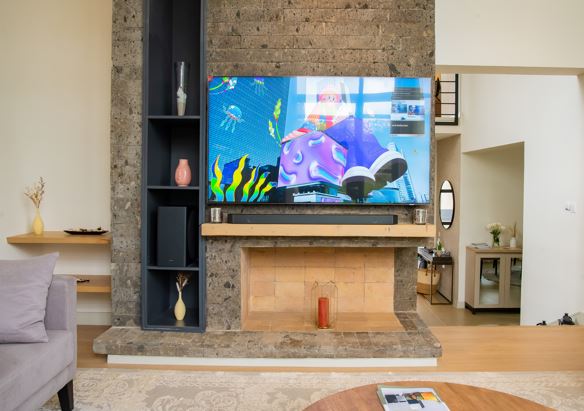Kenya’s television market is changing rapidly, with buyers demanding larger screens, sharper images, and longer-lasting value for their money.
Amid the flood of new models and flashy marketing terms, one name continues to dominate global ratings and industry awards for picture quality and reliability: Samsung QLED.
Backed by billions in research and development and certified by independent agencies for both performance and environmental safety, Samsung’s QLED televisions are the benchmark against which others are measured and not just another option on the shelf.
For Kenyan consumers weighing where to spend their hard-earned money, the evidence points clearly to why Samsung QLED is worth every shilling.
So what exactly is a “true QLED”?
In plain terms, a QLED television is an LCD television that uses an LED backlight shining through a layer of quantum dots, nanoscale particles that convert light with surgical precision.
That extra layer dramatically boosts colour volume and peak brightness compared to a standard LED LCD.
Samsung’s own explainer is unequivocal, “QLED technology uses an LED backlight that projects onto a quantum dot layer,” delivering greater brightness and more accurate colour than regular LCD.
Independent guides from the likes of Digital Trends, Consumer Reports, and TechRadar describe the same architecture, an LED LCD panel plus a dedicated quantum dot film. If the quantum dot layer is not there, it is not QLED, regardless of the badge on the TV.[1]
This is where the controversy matters. In late 2024, Ars Technica reported that one cheap TV brand had been accused of selling “quantum dot” televisions without actual quantum dots, following lab testing and a regulatory dispute abroad. While that brand has promoted many legitimate quantum dot models, the reporting showed why consumers should be cautious when a “QLED” price looks too good to be true.
In East Africa, Samsung has run “Real Quantum Dot” awareness campaigns urging buyers to verify certification, and Kenyan tech media have echoed warnings about “fake QLED” units flooding electronic shops across Kenya.
Why buy a Samsung QLED?
First, Samsung essentially industrialised QLED for TVs and continues to publish detailed materials on how its quantum dot film is made and why film quality determines colour purity and longevity.
Samsung notes that a “dedicated quantum dot film that contains sufficient quantum dots is key in delivering top-class picture quality and longevity.”
In 2025, Samsung’s QLED line earned “Real QD Display” recognition from TÜV Rheinland, and its quantum dot sheets were verified by SGS as containing no cadmium and complying with Europe’s RoHS hazardous substances directive.
These third-party recognitions, along with Samsung’s long-running QLED development, are exactly the kind of hard proof buyers should look out for in a market where mislabelling is rampant.
Second, value for money is not just about the price tag; it is what your screen delivers over the years. A true QLED achieves very high colour volume and high sustained brightness that punches through Kenyan living rooms in daylight, which is a known strength of Samsung’s QLED sets.
That is why mainstream reviewers continue to recommend Samsung’s QLED ranges for bright room viewing and watching sports. Entry models like the Samsung Q60D offer QLED colour at an accessible tier, while Neo QLED sets add a dense mini LED backlight for improved contrast control.
If a non-QLED panel is sold as QLED, you are paying for performance that you do not receive, which is the very definition of poor value.
Third, research and development is not a marketing gimmick, it is why picture quality keeps improving and why certifications exist. That scale funds the quantum dot chemistry, the backlight control, the processing, and the reliability testing that cheaper lookalikes do not replicate. When you buy from a brand that leads and documents the tech, you benefit from that investment for the lifetime of the TV.
Fourth, the environment. Early quantum dot systems in the industry could use cadmium, a toxic heavy metal. Samsung’s quantum dot film is certified cadmium free and RoHS compliant, which reduces hazardous substance risks in manufacturing and end of life. Samsung also adds practical sustainability touches such as low power processors, eco packaging, and the SolarCell remote, which reduces battery waste. These do not make a TV “green” on their own, but they are concrete improvements that complement the core product. If you see a bargain “QLED,” ask whether the manufacturer can point to independent certifications, especially on cadmium. If they cannot, that is a red flag.
Finally, the Kenyan price reality. Authorised retailers frequently price new Samsung QLEDs depending on series and promotions, while multiple shops list other “QLED” models at half the price.
If a set is half the price, there must be a clear technical explanation in the specifications, and you should be able to verify it on the manufacturer’s website and through certification marks on the box and the panel info menu. If you cannot, you may not be buying what you think you are.
What should you do?
The bottom line is simple. “QLED” is not a decorative sticker; it is a specific display architecture that relies on a quantum dot film.
Reports have shown that mislabelling can and does happen, which is why Kenyan buyers should insist on proof. Samsung provides that proof through public technical documentation, third-party “Real QD” certification, and a long track record of research and development investment.
If you want the colour, brightness, and durability that QLED promises, buy a Samsung QLED from an authorised dealer, check for the certification marks, and enjoy the picture you paid for.
That is real value for money.







More Stories
ibis Styles Nairobi Westlands Partners with AfriLabs and UNDP for the 2025 AfriLabs Annual Gathering at the UN
IPOA, DCI Launch Investigations into Solai Police Custody Death
Parliament Opens Public Submissions on National Honours Nominees